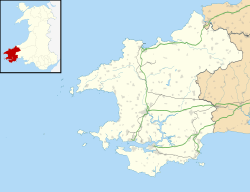| Lamphey Court | |
|---|---|
 | |
| Type | mansion |
| Location | Pembrokeshire, Wales |
| Coordinates | 51°40′25″N4°52′09″W / 51.6736°N 4.8691°W |
| OS grid reference | SN 0171 0110 |
| Built | 1823 |
Listed Building – Grade II* | |
| Official name | Lamphey Court |
| Designated | 14 May 1970 |
| Reference no. | 5968 |
| Community | Lamphey |
Lamphey Court is a Greek revival mansion north of the village of Lamphey, Pembrokeshire, South Wales built in 1823 by Charles Delamotte Mathias. It was designated at Grade II* in 1970 as an important Greek revival house of high architectural quality. [1] [2] [3] After restorations and extensions Lamphey Court was re-opened by the present owners in 1980. [2] It currently operates as a Best Western hotel.
The main facade is two storeys high and seven bays wide. A full height four column Ionic portico occupies the three centre bays which are recessed behind the columns. [2] The whole is rendered and whitened and the low hipped slate roofs are concealed behind a plain parapet. [3] The gardens and park are listed, jointly with the garden at Lamphey Bishop's Palace, as Grade II* on the Cadw/ICOMOS Register of Parks and Gardens of Special Historic Interest in Wales. [4]
